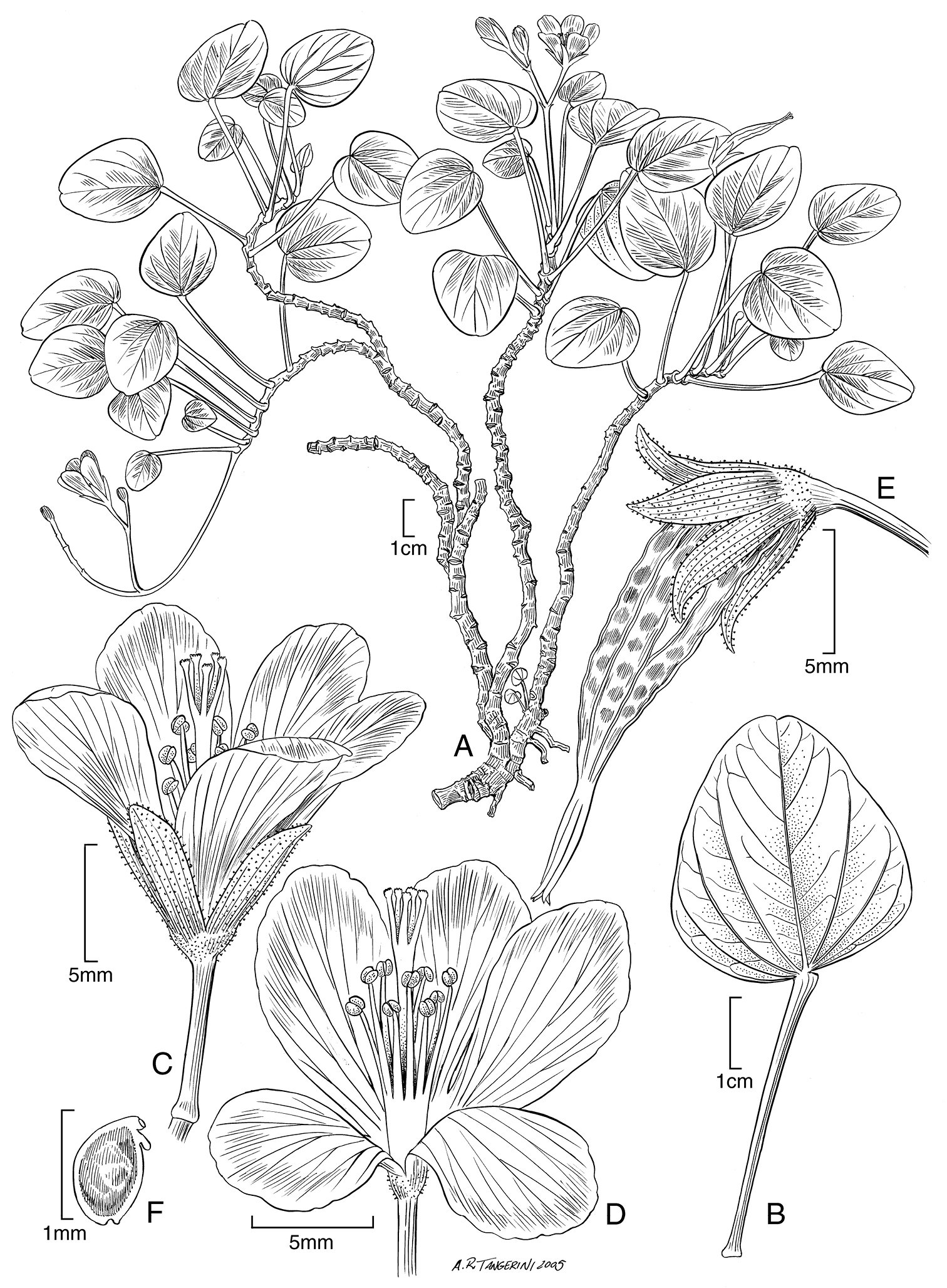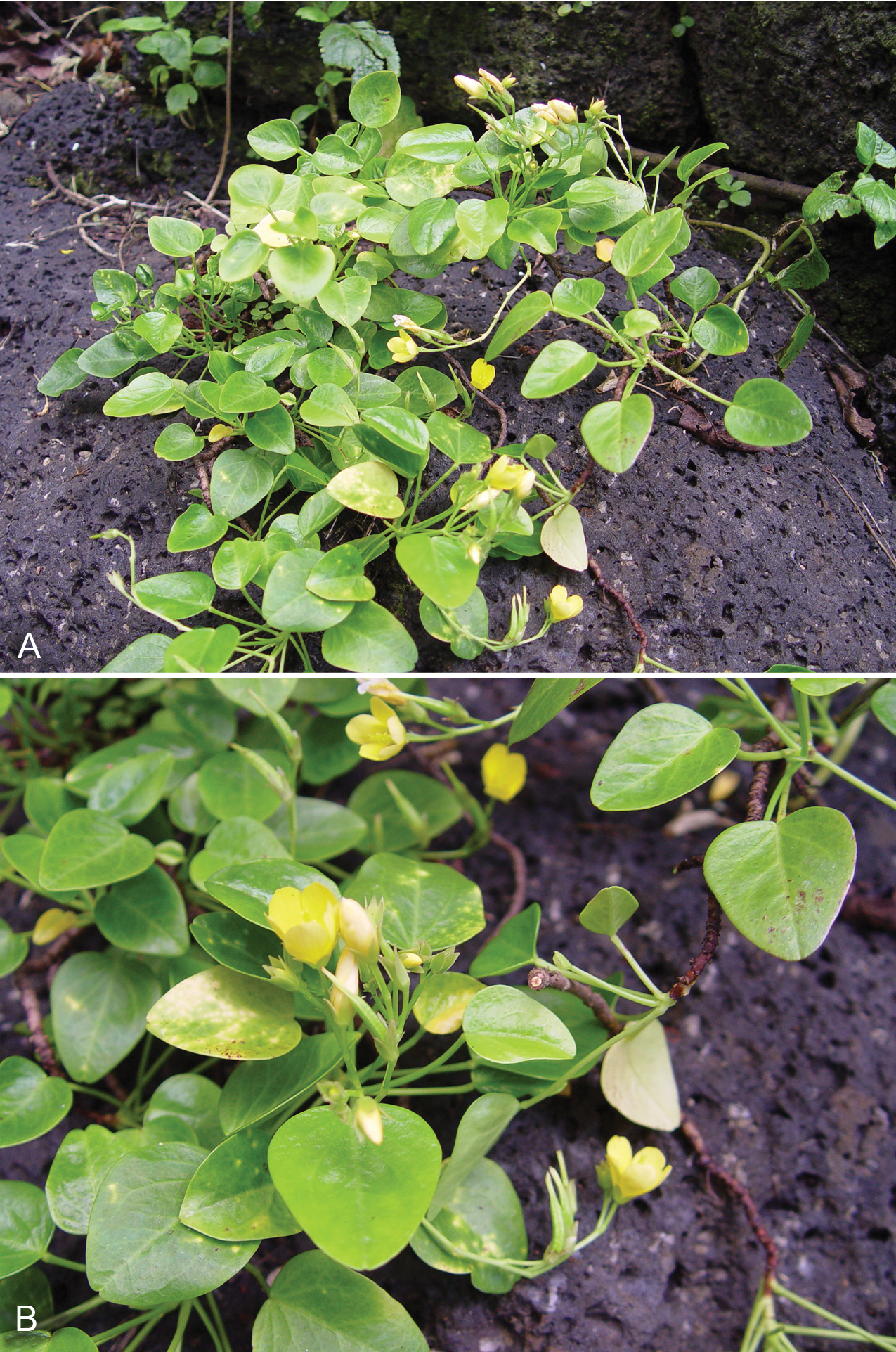






(C) 2011 David H. Lorence. This is an open access article distributed under the terms of the Creative Commons Attribution License, which permits unrestricted use, distribution, and reproduction in any medium, provided the original author and source are credited.
For reference, use of the paginated PDF or printed version of this article is recommended.
Oxalis simplicifolia Lorence & W. L. Wagner sp. nov., a new species from the Marquesas Islands (Ua Huka) is described and illustrated. It differs from the other Marquesas species, Oxalis gagneorum, in having simple, unifoliolate glabrous leaves, minutely glandular-puberulent calyx lobes, shorter corolla lobes, erect capsules, and smaller seeds. As its habitat is under serious threat from human impact, feral animals, and weeds, we conclude this new species should be added to the IUCN Red List as critically endangered (CR).
Conservation, French Polynesia, Marquesas Islands, Oxalis, Oxalidaceae, unifoliolate
Intensive botanical exploration of the Marquesas Islands
(French Polynesia) for the Vascular Flora of the Marquesas Islandsand
Flore de la Polynésie française projects has resulted in numerous
additional new collections from these islands. During the collecting
expeditions for the current Vascular Flora of the Marquesas Islands
project under the direction of David H. Lorence and Warren L. Wagner (
Oxalis
is a cosmopolitan genus of approximately 500 to 700 species with its
greatest diversity in South America and the African Cape region (
All measurements given herein are taken from dried
herbarium specimens, although certain features such as shapes were
supplemented with information from alcohol-preserved flowers and fruits,
field notes, and digital photos. Measurements are presented in the
descriptions as follows: length × width, followed by units of
measurement (mm or cm). All specimens cited in this paper have been seen
by the authors. The area of occupancy (distribution) for this species
was calculated using herbarium collection data and field observations,
and the conservation status is proposed following the IUCN Red List
Category criteria (
urn:lsid:ipni.org:names:77112690-1
http://species-id.net/wiki/Oxalis_simplicifolia
Figs 1, 2Ad Oxalidem gagneorum Fosberg & Sachet affinis sed in foliis simplicibus unifoliolatis glabris, in laminis ovatis vel late ovatis subpalmate nervatis, in lobis calycis minute glandulo-puberulis, in lobis corollae brevioribus 8-12 mm longis, in staminibus 5-8 mm longis, in capsulis maturis rectis et in seminis minoribus 0.8-0.9 × 0.5 mm differt.
MARQUESAS ISLANDS: Ua Huka: Hanahouua valley, back of valley below cliff walls, 457 m elevation, 8°54.47S, 139°30.89W, 26 June 2004, S. Perlman & K. R. Wood 19072 (holotype: PTBG-041184!; Isotypes: P!, PAP!, US!).
Perennial woody herbs or subshrubs 20–50 cm tall, stems prostrate or sprawling to erect, branching from near base, with sparse lateral branches, glabrous or new growth sparsely pilose, mature twigs 2–3 mm diam, bark smooth, reddish brown to dark brown, with tufts of pilose hairs at thickened, persistent leaf bases. Leaves simple, spirally arranged; blade dark green above, yellow-green below, firm and moderately coriaceous when fresh, chartaceous when dry, glabrous, (15–) 20–47 × (12–)18–37 mm ovate to broadly ovate, base obtuse to rounded or truncate, apex obtuse, tip usually emarginate, venation subpalmate with 1–2(–3) pairs of secondary veins from base and 2–3 pairs along midrib above, venation raised and visible to 3° above and to 4° beneath; margin thin, plane; petiole (20–) 25–45 × 0.6–0.8 mm, sparsely scattered pilose or glabrescent, flattened, adaxially sulcate, distally with slight pulvinus. Inflorescences axillary near ends of branches, cymose, 5–13–flowered, 5–8 cm long, peduncles 4–5 cm long, terminating in apical flower and two monochasial lateral branches 18–40 mm long each with 2–6 flowers, bracts linear-subulate, 1–2 × 0.3–0.4 mm, sparsely puberulent with acicular and scattered glandular-tipped trichomes. Flowers (long-styled morph seen) with 5 calyx lobes 5–7 × 1.7–2 mm, narrowly ovate-oblong, 6–8-veined, apex acute, both surfaces minutely glandular-puberulent with capitate trichomes; petals yellow, 10–12 × 5 mm, narrowly obovate to oblong-elliptic, 7–9-veined, apex obtuse to rounded; stamens 10, in two series, the longer 7–8 mm long, the shorter 5.5–6 mm long, filaments connate basally, anthers broadly ellipsoid, 0.4–0.5 mm long, reniform to subcircular; gynoecium 10-14 mm long, with ovary 6–7 mm long, narrowly ovoid-cylindrical, externally glabrous, beak 4–5 mm long, styles 5, 1–2.5 mm long, stigmas slightly thickened, papillose, not bifid. Fruits ovoid-cylindrical, 10–11 × 2–2.5 mm, at maturity apparently straight and not twisting, externally glabrous, carpels 5, villous within, seeds ca. 40. Seeds ellipsoid, compressed, 0.8–0.9 × 0.5 mm, surface shiny, brown, rugose.
Oxalis simplicifolia Lorence & WL Wagner A habit B leaf C, D flowers E fruit F seed. Drawn from the type collection (Perlman & Wood 10972) and field images.
Known only from Ua Huka, Marquesas Islands.
Known only from two localities on Ua Huka, this new species occurs in shrubby and herbaceous vegetation on vertical basalts cliff above a mesic to wet lowland forest zone with Freycinetia impavida (Gaudich. ex Hombr.) B.C. Stone, Hibiscus tiliaceus L., Pandanus tectorius Parkinsonр and Pisonia grandis R. Br. Plants grow scattered on cliffs rooting in rock crevices (Figures 2A, B). Oxalis gagneorum occurs sympatrically or nearly so with Oxalis simplicifolia at both Hanahouua (Perlman and Meyer 19748) and Hane/Hokatu (Wood & Meyer 10530, 10551).
Field images of Oxalis simplicifolia A habit B stems with flowers and fruits (Perlman & Wood 10972).
The specific epithet refers to the simple, unifoliolate leaves.
Following the criteria and categories of
Marquesas Islands: Ua Huka: Hanahouua valley, back of valley on ridge between Hanahouua and Hanalei, 8°54.47S, 139°30.87W, 488 m, 28 July 2005, S. P. Perlman, J.-Y. Meyer 19748 (PTBG); Hane/Hokatu cliff, zone, 520 m, 11 Dec 2003, K. R. Wood, J.-Y. Meyer 10512 (PAP, PTBG, US).
Although the majority of Oxalis
species have palmately compound leaves with three (rarely to nine)
leaflets, several taxa with unifoliolate leaves occur in South America
in subgenus Thamnoxys (
This new species may be related to the Marquesas endemic Oxalis gagneorum,
from which it differs by its glabrous simple, unifoliolate leaves
with ovate to broadly ovate blades having subpalmate venation of one to
three basal vein pairs, minutely glandular puberulent calyx lobes,
shorter corolla lobes 8–12 mm long, shorter stamens 5–8 mm long,
capsules not twisting at maturity (they often twist in Oxalis gagneorum), and smaller seeds 0.8–0.9 × 0.5 mm (Table 1).
Distinguishing morphological features of Oxalis gagneorum and Oxalis simplicifolia.
| Character | Oxalis gagneorum | Oxalis simplicifolia |
|---|---|---|
| Height (m) | 0.3–1.2 | 0.2–0.5 |
| Stem pubescence | young growth pilose | glabrous or sparsely pilose |
| Leaflet pubescence | pilose-strigose below | glabrous |
| Leaflet number | 3 | 1 |
| Leaflet shape | broadly obovate or oblong-elliptic | ovate to broadly ovate |
| Leaflet blade length (mm) | 35 | (20–) 25–47 |
| Leaf blade width (mm) | 26 | (12–) 18–37 |
| Venation | pinnate | subpalmate |
| Secondary vein pairs | 5–7 | 1–2 (–3) basal, 2–3 above |
| Flowers per inflorescence | 3–5 | 5–13 |
| Calyx lobe shape | ovate | ovate-oblong |
| Calyx lobe length (mm) | 4–6 | 5–7 |
| Calyx lobe width (mm) | 2–3 | 1.7–2 |
| Calyx pubescence | sparsely pilose | minutely glandular puberulent |
| Corolla lobe length (mm) | 12–35 | 8–12 |
| Corolla lobe width (mm) | 3–5 | 5 |
| Corolla lobe shape | narrowly obovate to spathulate, clawed | narrowly obovate to oblong-elliptic |
| Shorter stamen length (mm) | 11–14 | 5–5.6 |
| Longer stamen length (mm) | 14–16 | 7–8 |
| Fruit shape | Broadly cylindrical, twisting at maturity | Ovoid-cylindrical, not twisting at maturity |
| Fruit length (mm) | 9–15 | 10–11 |
| Fruit width (mm) | 3–4 | 2–2.5 |
| Seed length (mm) | 1.3–1.4 | 0.8–0.9 |
| Seed width (mm) | 0.8–1.2 | 0.5 |
| Seed surface | shiny, brown, rugose | shiny, brown, rugose |
Oxalis species often have different floral morphs, frequently tristylous or sometimes distylous (
This study was greatly facilitated by field observations, photos, and specimens provided by Ken Wood and Steve Perlman (National Tropical Botanical Garden) as part of the Vascular Flora of the Marquesas Islands project, which was supported by a generous private donation. We are grateful to Jean-Yves Meyer and staff of the Délégation à la Recherche (Papeete, Tahiti), the Musée de Tahiti et des Iles, and the Service du Développement Rural for logistic support, the Délégation for permission to collect in the Marquesas and the Délégation and the Haut-Commissariat de la République en Polynésie française for permission to conduct research. The illustration was skillfully drawn by Alice Tangerini (Smithsonian Institution). We thank Eve Emshwiller and Stephen Weller for reviewing the manuscript and useful discussions and Harold Robinson for translating the Latin diagnosis. The contribution by WLW to this study was partially supported by the Smithsonian Research Opportunities Fund and while appointed as McBryde Chair at the National Tropical Botanical Garden.

